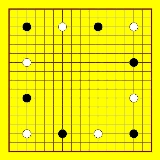
Go variants
Encyclopedia
There are many variations on the basic game of Go
. Some are ancient digressions, while other are modern deviations. They are often to be found as side events at tournaments, for instance the U.S. Go Congress, has a "Crazy Go" evening scheduled each year.
.
There are some versions that are so distinct as to be considered variants. In other cases the effect of rule differences on actual play is minor, but for these the tactical consequences are substantive.
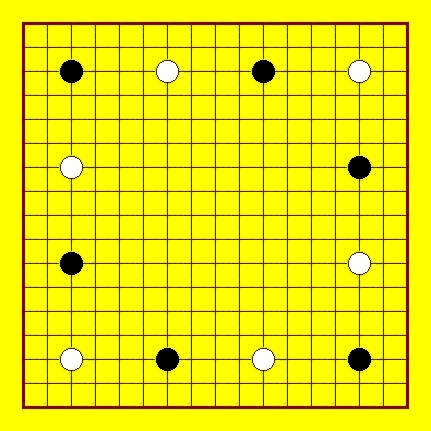 Tibetan Go is played on a 17×17 board, and starts with six stones (called Bo) from each colour placed on the third line as shown. White makes the first move. It has a unique ko rule: one may not play a stone at an intersection where the opponent has just removed a stone. This ko rule is so different from the other major rulesets that it alone significantly changes the character of the game. For instance, snapbacks must be delayed by at least one move, allowing an opponent a chance to create life. Finally, a player who controls all four corner points (the 1-1 points) gets a bonus of 40 points, and if he also controls the centre point he gets a further bonus of 10 points. (Control means occupies or surrounds.)
Tibetan Go is played on a 17×17 board, and starts with six stones (called Bo) from each colour placed on the third line as shown. White makes the first move. It has a unique ko rule: one may not play a stone at an intersection where the opponent has just removed a stone. This ko rule is so different from the other major rulesets that it alone significantly changes the character of the game. For instance, snapbacks must be delayed by at least one move, allowing an opponent a chance to create life. Finally, a player who controls all four corner points (the 1-1 points) gets a bonus of 40 points, and if he also controls the centre point he gets a further bonus of 10 points. (Control means occupies or surrounds.)
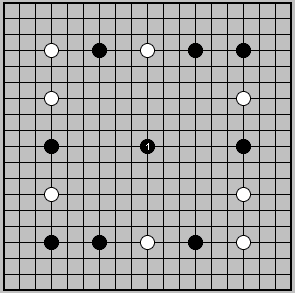 A different form of Go (baduk) evolved in Korea called sunjang baduk. It has been played from at least the 7th century. Its most distinctive feature is the prescribed opening. The starting position dictates the placement of 16 stones (8 black, 8 white) as shown, and the first move is prescribed for Black at the center of the board. However, the counting system for determining territory at the end of the game also has some important differences. Namely, stones internal to territory and irrelevant to boundary definition, are removed before counting territory.
A different form of Go (baduk) evolved in Korea called sunjang baduk. It has been played from at least the 7th century. Its most distinctive feature is the prescribed opening. The starting position dictates the placement of 16 stones (8 black, 8 white) as shown, and the first move is prescribed for Black at the center of the board. However, the counting system for determining territory at the end of the game also has some important differences. Namely, stones internal to territory and irrelevant to boundary definition, are removed before counting territory.
is a modern Korean variant. The name stems from a combination of the Korean words baduk and juntoo (“battle”). It is played entirely in cyberspace
, and differs from standard Go in a number of ways, most noticeably in the way in which certain areas of the board are worth different points values. The other principle difference is that both players place three stones before the game begins, and may also place a special “hidden stone”, which affects the board as a regular stone but is invisible to the opponent. Batoo has become very popular among young people in Korea.
, adds an element of mathematical precision to the game. In lieu of playing a stone, a player may take the highest remaining card from a pack of cards valued in steps of ½ from ½ to 20: the player's score will be the territory captured, plus the total value of cards taken. In effect, the players participate in a downward auction for the number of points they think sente is worth at each stage in the game.
The professional players Jiang Zhujiu and Rui Naiwei played the first Environmental Go game in April 1998. Since then the variant has seen little activity on the international scene.
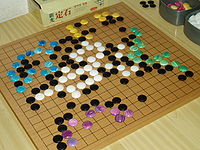 In Multi-player Go, stones of different colors are used so that four players or more can play on one board.
In Multi-player Go, stones of different colors are used so that four players or more can play on one board.
. Indeed, most club standard players can play blind chess, but only professional players are able to complete a game of blind 19×19 Go.
, which allows board sizes from 2×2 to 38×38.
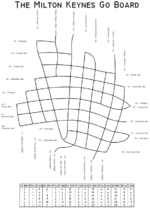 The annual Milton Keynes
The annual Milton Keynes
Go Tournament has a popular side-event that is played on a stylised map of Milton Keynes. Its non-conventional lattice presents some interesting possibilities.
Harald Schwarz invented a Go variant that is played on a circular lattice.
A toroidal
board is two dimensional surface with an implied third dimension because it is as if a standard board has been rolled and two opposite edges joined to form a tube and then the ends of the tube joined. It can be simulated on a standard 19×19 board, but requires imagination on the part of the players to perform an abstract join at the edges. It is noteworthy that the toroidal board has no corners, so standard joseki
do not apply. This kind of variant can also be performed with three other identifications, see Surface construction from polygons.
TriGo is a go variant that uses a triangular-grid goban, where each stone has up to six liberties. To compensate for this, there are several rule changes: ko and superko are limited in scope, komi
is not used, and after the first stone is placed, every turn consists of placing two stones. After both players have passed a turn, the score is counted (the sum of captured stones and territory), and in the case of a draw the player passing first wins.
 Alak is a Go-like game restricted to a single spatial dimension
Alak is a Go-like game restricted to a single spatial dimension
.
Go can be extended to three dimensions
. An example is Diamond Go, which uses the structure of a carbon
diamond
crystal lattice. With many Go variants, the nature of the game changes dramatically if they do not keep the standard 4-connectivity of the points, which Diamond Go maintains.
A program called Freed Go can be used to play with boards with generic topology
. It has embedded 11 different boards, either three-dimensional shapes (including cube
, sphere
, cylinder
, diamond
, torus
and Mobius strip
) or flat fields with points connected to three, five or six neighboring points, but it's also possible to create custom boards.
Go (board game)
Go , is an ancient board game for two players that originated in China more than 2,000 years ago...
. Some are ancient digressions, while other are modern deviations. They are often to be found as side events at tournaments, for instance the U.S. Go Congress, has a "Crazy Go" evening scheduled each year.
National variants
The difficulty in defining the rules of Go has led to a situation where there are many subtly different rulesets in existence. They are distinct over such areas as scoring method, ko, suicide, handicap placement and what to do about neutral points at the end of the game. In the main these differences are small enough to avoid changing the character and strategy of the game, so we do not consider them here. For more information, see Rules of GoRules of Go
This is an in-depth discussion of the rules of go.There has been a certain amount of variation in the rules of go over time, and from place to place. This article discusses those sets of rules broadly similar to the ones currently in use in East Asia. Even among these, there is a degree of...
.
There are some versions that are so distinct as to be considered variants. In other cases the effect of rule differences on actual play is minor, but for these the tactical consequences are substantive.
Tibetan Go

Sunjang Baduk

Bangneki
In another Korean variant, bangneki, the players wager on the outcome of the game. A fixed stake ("bang") is paid for every ten points on the board by which the loser is beaten.Batoo
BatooBatoo
Batoo is a Korean variant of the board game Go. The name stems from a combination of the Korean words baduk and juntoo . It is played entirely in cyberspace, and differs from Go in a number of ways, most noticeably in the way in which certain areas of the board are worth different point values...
is a modern Korean variant. The name stems from a combination of the Korean words baduk and juntoo (“battle”). It is played entirely in cyberspace
Cyberspace
Cyberspace is the electronic medium of computer networks, in which online communication takes place.The term "cyberspace" was first used by the cyberpunk science fiction author William Gibson, though the concept was described somewhat earlier, for example in the Vernor Vinge short story "True...
, and differs from standard Go in a number of ways, most noticeably in the way in which certain areas of the board are worth different points values. The other principle difference is that both players place three stones before the game begins, and may also place a special “hidden stone”, which affects the board as a regular stone but is invisible to the opponent. Batoo has become very popular among young people in Korea.
First Capture
The first player to capture a stone wins. It was invented by Japanese professional Yasutoshi Yasuda who describes it in his book Go As Communication. Yasuda was first inspired by the need for a medium to address the problem of bullying in Japan, but soon found that "First Capture" also works as an activity with senior citizens and even developmentally delayed individuals. He sees it as a game in its own right, not just as a prelude to Go, but also as a way to introduce simple concepts that lead to Go. For the latter purpose, he recommends progressing to "Most Capture", in which the player capturing the most stones wins; then it is natural to introduce the idea of capturing territory, not just the opponent's stones. This variation is often called Atari Go in the West, where it is becoming increasingly popular as a preliminary means of introducing Go itself to beginners.Environmental Go
Environmental Go, invented by Elwyn BerlekampElwyn Berlekamp
Elwyn Ralph Berlekamp is an American mathematician. He is a professor emeritus of mathematics and EECS at the University of California, Berkeley. Berlekamp is known for his work in information theory and combinatorial game theory....
, adds an element of mathematical precision to the game. In lieu of playing a stone, a player may take the highest remaining card from a pack of cards valued in steps of ½ from ½ to 20: the player's score will be the territory captured, plus the total value of cards taken. In effect, the players participate in a downward auction for the number of points they think sente is worth at each stage in the game.
The professional players Jiang Zhujiu and Rui Naiwei played the first Environmental Go game in April 1998. Since then the variant has seen little activity on the international scene.
Cards Go
In Cards Go players draw from a pack of cards contain instructions to play one of a fixed set of commonly occurring shapes. If the said shape cannot be placed on the board, then an illegal move is deemed to have been played: this necessitates resignation.Multi-player Go

Paper and Pencil Go
Paper and Pencil Go is a Go variant that can be played just with paper and pencil. Unlike in standard Go, games played under these rules are guaranteed to end in a finite number of moves, and no ko rules are needed. It differs from standard Go in the following aspects:- Immediately after each play, every group (Black or White) which hasn't got any liberties is marked. If a marked group is touched by just one player's unmarked groups, it is considered a liberty for those groups, and it counts as territory for that player. Otherwise, it is a neutral area, and doesn't constitute a liberty.
- All marked stones are considered equal, regardless of color, and the points they occupy are not eligible to play. This implies that any group which touches a marked group is unconditionally alive, unless an opponent group also touches the same marked group.
- Suicide is allowed, i.e., you can make a play such that one or more of your own stones become marked.
- Area scoring is used.
Rengo
This involves two teams of players taking either the Black or the White stones. Each player in the team must play in turn, playing out of sequence will normally result in a small penalty (usually three prisoners). Partners may not consult on how to play, or engage in any form of signaling. Communication between partners may only take the following forms listed below.- May we resign? can be answered with yes or no
- How much time is left? can be answered with coded instructions for the next move. For example, the response 5 minutes and 13 seconds could be a hint to play at the co-ordinates 5-13.
- Whose turn is it?
Pair Go
Pair Go is a gender specific form of Rengo, calling for teams composed of one male and one female member. It was popularised by the Japan Pair Go Association as a means of increasing female participation in the game. They hoped that this increase in itself would add a new appeal to the game. The Ricoh Cup, the annual professional Pair Go world championship debuted in 1994. The International Pair Go Association sponsors an annual amateur world championship in Tokyo in November, which has been running uninterrupted since 1989. They first introduced the variant to Europe at the 1992 European Congress in Canterbury, England. Amateur Pair Go tournaments have been held in the United States at U.S. Go Congresses since 2005 at least and in Denver, CO.Blind Go
One (as a handicap) or both of the players cannot see the board in this variant. Therefore they have to remember the whole position. This is considered much more difficult than playing blind chessChess
Chess is a two-player board game played on a chessboard, a square-checkered board with 64 squares arranged in an eight-by-eight grid. It is one of the world's most popular games, played by millions of people worldwide at home, in clubs, online, by correspondence, and in tournaments.Each player...
. Indeed, most club standard players can play blind chess, but only professional players are able to complete a game of blind 19×19 Go.
One Color Go
Both players use stones of the same color. This variation is regarded as a useful tool for developing one's reading skills.Variants with limited knowledge of the position
These variants are not purely strategic games, as the element of luck is quite important.Shadow Go
This game requires two players, a referee and three playing sets. Each player sees only his own board, while the referee can see them both and also have his own set. Players place stones on their boards, with no knowledge of what other players are doing. A referee keeps track of the game on the central board. If any player makes an illegal move, the referee informs him about it (some play that the referee says only that the move is illegal, while some, that the player is told whether the intersection is occupied or there is illegal ko capture). The player is allowed to make another move.Rengo Kriegspiel
This is a crossover between rengo and shadow Go. There are two teams with two players each, a referee and five Go sets. The players move alternatingly as in rengo. Each player keeps track of their own moves on their own board; they are not informed about teammates' or opponents' moves. The referee keeps track of the complete game and informs a player if their move was illegal, in which case they can try again. The referee removes captured stones from all affected boards. Because of the asymmetry in information, this may be an undecidable game; which would mean that there is in principle no computer or algorithm that can tell from a given position who will win.Non-standard boards
Although Go is most commonly played on a board with 19×19 lines, 9×9 and 13×13 boards are also available. They are used by beginners and by players who want a game that finishes more quickly. Due to flexibility of configuration, the two smaller sizes are more often played on the online Go servers such as KGS Go ServerKGS Go Server
The KGS Go Server, known until 2006 as the Kiseido Go Server, is a game server first developed in 1999 and firmly established in 2000 for people to play Go. The system was developed by William M. Shubert and its code is now written entirely in Java...
, which allows board sizes from 2×2 to 38×38.

Milton Keynes
Milton Keynes , sometimes abbreviated MK, is a large town in Buckinghamshire, in the south east of England, about north-west of London. It is the administrative centre of the Borough of Milton Keynes...
Go Tournament has a popular side-event that is played on a stylised map of Milton Keynes. Its non-conventional lattice presents some interesting possibilities.
Harald Schwarz invented a Go variant that is played on a circular lattice.
A toroidal
Torus
In geometry, a torus is a surface of revolution generated by revolving a circle in three dimensional space about an axis coplanar with the circle...
board is two dimensional surface with an implied third dimension because it is as if a standard board has been rolled and two opposite edges joined to form a tube and then the ends of the tube joined. It can be simulated on a standard 19×19 board, but requires imagination on the part of the players to perform an abstract join at the edges. It is noteworthy that the toroidal board has no corners, so standard joseki
Joseki
In Go, are studied sequences of moves in the corner areas of the Go board, for which the result is considered balanced for both black and white sides. Because games typically start with plays in the corners, players often try to use their understanding of joseki to gain local advantages in the...
do not apply. This kind of variant can also be performed with three other identifications, see Surface construction from polygons.
TriGo is a go variant that uses a triangular-grid goban, where each stone has up to six liberties. To compensate for this, there are several rule changes: ko and superko are limited in scope, komi
Komidashi
in the game of Go are points added to the score of the player with the white stones as compensation for playing second. Black's first move advantage is generally considered to equal somewhere between 5 and 7 points by the end of the game. Standard komi is 6.5 points under the Japanese and Korean...
is not used, and after the first stone is placed, every turn consists of placing two stones. After both players have passed a turn, the score is counted (the sum of captured stones and territory), and in the case of a draw the player passing first wins.
Other than 2D

Dimension
In physics and mathematics, the dimension of a space or object is informally defined as the minimum number of coordinates needed to specify any point within it. Thus a line has a dimension of one because only one coordinate is needed to specify a point on it...
.
Go can be extended to three dimensions
Three-dimensional space
Three-dimensional space is a geometric 3-parameters model of the physical universe in which we live. These three dimensions are commonly called length, width, and depth , although any three directions can be chosen, provided that they do not lie in the same plane.In physics and mathematics, a...
. An example is Diamond Go, which uses the structure of a carbon
Allotropes of carbon
This is a list of the allotropes of carbon.-Diamond:Diamond is one of the most well known allotropes of carbon. The hardness and high dispersion of light of diamond make it useful for both industrial applications and jewellery. Diamond is the hardest known natural mineral. This makes it an...
diamond
Diamond cubic
The diamond cubic crystal structure is a repeating pattern of 8 atoms that certain materials may adopt as they solidify. While the first known example was diamond, other elements in group IV also adopt this structure, including tin, the semiconductors silicon and germanium, and silicon/germanium...
crystal lattice. With many Go variants, the nature of the game changes dramatically if they do not keep the standard 4-connectivity of the points, which Diamond Go maintains.
A program called Freed Go can be used to play with boards with generic topology
Topology
Topology is a major area of mathematics concerned with properties that are preserved under continuous deformations of objects, such as deformations that involve stretching, but no tearing or gluing...
. It has embedded 11 different boards, either three-dimensional shapes (including cube
Cube
In geometry, a cube is a three-dimensional solid object bounded by six square faces, facets or sides, with three meeting at each vertex. The cube can also be called a regular hexahedron and is one of the five Platonic solids. It is a special kind of square prism, of rectangular parallelepiped and...
, sphere
Sphere
A sphere is a perfectly round geometrical object in three-dimensional space, such as the shape of a round ball. Like a circle in two dimensions, a perfect sphere is completely symmetrical around its center, with all points on the surface lying the same distance r from the center point...
, cylinder
Cylinder (geometry)
A cylinder is one of the most basic curvilinear geometric shapes, the surface formed by the points at a fixed distance from a given line segment, the axis of the cylinder. The solid enclosed by this surface and by two planes perpendicular to the axis is also called a cylinder...
, diamond
Diamond cubic
The diamond cubic crystal structure is a repeating pattern of 8 atoms that certain materials may adopt as they solidify. While the first known example was diamond, other elements in group IV also adopt this structure, including tin, the semiconductors silicon and germanium, and silicon/germanium...
, torus
Torus
In geometry, a torus is a surface of revolution generated by revolving a circle in three dimensional space about an axis coplanar with the circle...
and Mobius strip
Möbius strip
The Möbius strip or Möbius band is a surface with only one side and only one boundary component. The Möbius strip has the mathematical property of being non-orientable. It can be realized as a ruled surface...
) or flat fields with points connected to three, five or six neighboring points, but it's also possible to create custom boards.
See also
- Abstract strategy gameAbstract strategy gameAn abstract strategy game is a strategy game, aiming to minimise luck, and without a theme. Almost all abstract strategy games will conform to the strictest definition of: a board or card game, in which there is no hidden information, no non-deterministic elements , in which two players or teams...
for other board games sometimes compared to Go - Games played with Go equipmentGames played with Go equipmentMany games can be played with Go equipment: a supply of white and black stones and a board with 19×19 intersections, other than Go and many more can be played with minor modification....
External links
- The North American pair go circuit
- Go Variants at World of Abstract Games, with sections on Other Rules, Other Boards, Other Pieces, and Other players; well illustrated
- Go Variants, by Andre Engels, text descriptions
- Topological Go, including a mathematical discussion
- Sensei's Go variants on Sensei's LibrarySensei's LibrarySensei's Library is an internet website and wiki, dedicated to articles about, and discussion of, the game of Go. It is one of the largest and most active wikis outside of the Wikipedia project on the internet. Sensei's Library was started in September 2000, by the Go players Morten Pahle and Arno...
- Freed Go, board with generic topologyTopologyTopology is a major area of mathematics concerned with properties that are preserved under continuous deformations of objects, such as deformations that involve stretching, but no tearing or gluing...
- World Batoo League

